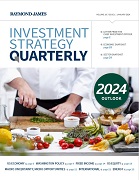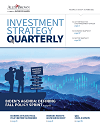Senior Investment Strategist Tracey Manzi shares why the journey to lower interest rates isn’t likely to proceed in a straight line.
To read the full article, see the Investment Strategy Quarterly publication linked below.
Key takeaways:
- Stronger-than-expected growth, concerns about the U.S. government’s fiscal outlook and the Federal Reserve’s (Fed’s) pledge to keep interest rates higher for longer drove yields to levels not seen in decades.
- Bonds now offer an attractive source of income, reasonable yield cushion to offset adverse movements in interest rates or spreads, potential capital appreciation and diversification from equities.
- Bonds have historically performed well leading into an easing cycle.
The bond markets had what proved to be another challenging year in 2023. Stronger-than-expected growth, concerns about the U.S. government’s fiscal outlook and the Federal Reserve’s (Fed’s) pledge to keep interest rates higher for longer drove yields (particularly longer-dated maturities) to levels not seen in decades. After the 10-year Treasury yield climbed above the psychologically important 5.0% level in October 2023, yields headed sharply lower in the final months of the year. While interest rates are well off their recent peaks, yields still stand near their highest levels in nearly 15 years. And with a Fed easing cycle coming into view in 2024, we think yields will trend lower in the months ahead. Although, the journey to lower interest rates is unlikely to proceed in a straight line.
Bonds have historically delivered strong, positive returns when Fed policy is transitioning into an easing cycle. This should be welcome news for fixed income investors who have endured significant volatility and two back to back years of losses. But, as challenging as the last few years have been, there is a silver lining for investors – and that is, the great rate reset has restored yields to more normal levels. And, with yields now at their highest levels in decades, investors can once again reap the benefits of owning bonds.
Macro outlook supports our call for lower bond yields
Despite calls for a recession in 2023, the economy remained remarkably resilient. While the long-awaited slowdown has been delayed, we still believe that a recession is coming as the tailwinds that supported growth are fading. Fed policy is restrictive. The long and variable lags of monetary policy are still working their way through the economy and are expected to become a bigger drag on growth as we progress through 2024. While the market may be overly optimistic about what the Fed will deliver in 2024, we do believe that policy rates are headed lower given our expectation for a mild recession next year.
What is up for debate is the pace and magnitude of the Fed’s expected rate cuts in the upcoming easing cycle. Policymakers will likely err on the side of caution in lowering interest rates as concerns about a renewed spike in inflation or a re-acceleration in growth could derail their progress to date. However, if a sharper than expected slowdown materializes or inflation decelerates at a more rapid clip (not our base case), Fed officials have plenty of room to lower rates to cushion the downturn. Given the economy’s resilience to the Fed’s aggressive rate hikes and the unusual nature of this cycle, volatility is likely to remain elevated as the economy normalizes.
Therefore, the tug-of-war between the market’s expectation for rates cuts and the Fed’s forward guidance is likely to persist. But ultimately, we do believe that the direction for policy rates and Treasury yields will be lower.
Bonds perform well leading into an easing cycle
Bonds have historically performed well leading into an easing cycle. In fact, once the Fed delivers its final rate hike, yields begin to move lower as the market starts to anticipate the next easing cycle. In the last six cycles, the period between the Fed’s last rate hike and the first rate cut (i.e., the ‘pause’) averaged around seven months. Applying this average to the current cycle suggests that the Fed could kick off its next easing cycle as early as the first quarter of 2024 – which coincidentally aligns with the timing of the first rate cut according to the fed funds futures contracts. While caution is warranted when looking at averages, as every cycle is different, it is worth noting that on average, 2-year and 10-year Treasury yields have declined ~100 basis points during the pause period. Yields fell even further once the Fed started cutting rates. More importantly, high quality bonds delivered strong, positive returns after the Fed’s tightening cycle ended. We think the next cycle will deliver similar results.
Yields have not been this attractive in decades
Aside from electing a president and a new Congress, D.C. will enter 2024 with an important to-do list, including government funding and responding to a changing global security environment. A first-mover for investors to watch will be the government funding debate, with new deadlines set for January 19 for four of the twelve appropriations bills and February 2 for the remaining eight bills. Temporary government shutdowns and triggers of 1% across-the-board spending cuts remain possible, which could add to market volatility in the first quarter. While near-term economic concerns have been raised about a potential slump in near-term fiscal support given the spending cut discussions, we would point to the implementation of major infrastructure legislation (including the bipartisan infrastructure law and the Inflation Reduction Act) which will continue to be deployed and have significant macroeconomic impacts.
The inflation surge following the pandemic has shifted the investment landscape. After a decade or more of extraordinarily low bond yields, interest rates have risen to levels not seen in decades. While the process of getting here has been painful, there is a silver lining for investors – and that is, the income is back in fixed income. This is important because the starting level of yields has historically been one of the best predictors of future returns.
While the majority of a bond’s return potential comes from the income component, the opportunity to capture some capital appreciation from a move lower in bond yields is an added bonus for investors. And with a Fed easing cycle coming into focus, we think it would be prudent for investors to consider taking on some additional duration risk and locking in these higher yields while they are still available. This is especially true for investors who have been riding out the storm in cash or cash-equivalents earning competitive yields of 5.0% or higher. While cash yields are attractive today, the allure will quickly fade once the Fed starts cutting rates. In fact, history has shown that cash and cash-equivalents underperform intermediate and longer-maturity bonds by a significant margin after the Fed delivers its last rate hike.
Looking forward
Our optimism about bonds is driven by the high starting level of yields. While this was true in 2023, it is even truer in 2024. With yields across the fixed income spectrum near their highest levels in nearly 15 years, bonds have not looked this attractive on an absolute basis or relative to equities for a long time. Fixed income has the ability to generate mid-single digit returns or greater in 2024. As growth and inflation momentum slows, we look for lower yields and steeper curves in the months ahead. Given our outlook for a mild recession, we favor the higher-quality sectors of the bond market, which include Treasurys, investment-grade corporates and municipal bonds. While high yield bonds offer enticing yields, we remain cautious on the sector given deteriorating fundamentals (i.e., rising defaults, higher bankruptcies, falling interest coverage ratios) and tight credit spreads.

Read the full
Investment Strategy Quarterly
Read the full
Investment Strategy Quarterly
All expressions of opinion reflect the judgment of the Chief Investment Office, and are subject to change. This information should not be construed as a recommendation. The foregoing content is subject to change at any time without notice. Content provided herein is for informational purposes only. There is no guarantee that these statements, opinions or forecasts provided herein will prove to be correct. Past performance may not be indicative of future results. Asset allocation and diversification do not guarantee a profit nor protect against loss. The S&P 500 is an unmanaged index of 500 widely held stocks that is generally considered representative of the U.S. stock market. Keep in mind that individuals cannot invest directly in any index, and index performance does not include transaction costs or other fees, which will affect actual investment performance. Individual investor’s results will vary. Investing in small cap stocks generally involves greater risks, and therefore, may not be appropriate for every investor. International investing involves special risks, including currency fluctuations, differing financial accounting standards, and possible political and economic volatility. Investing in emerging markets can be riskier than investing in well-established foreign markets. Investing in the energy sector involves special risks, including the potential adverse effects of state and federal regulation and may not be suitable for all investors. There is an inverse relationship between interest rate movements and fixed income prices. Generally, when interest rates rise, fixed income prices fall and when interest rates fall, fixed income prices rise. If bonds are sold prior to maturity, the proceeds may be more or less than original cost. A credit rating of a security is not a recommendation to buy, sell or hold securities and may be subject to review, revisions, suspension, reduction or withdrawal at any time by the assigning rating agency. Investing in REITs can be subject to declines in the value of real estate. Economic conditions, property taxes, tax laws and interest rates all present potential risks to real estate investments. The companies engaged in business related to a specific sector are subject to fierce competition and their products and services may be subject to rapid obsolescence.
Markets & Investing April 01, 2024 Raymond James CIO Larry Adam reminds investors they need to be well...
Markets & Investing April 01, 2024 Doug Drabik discusses fixed income market conditions and offers...
Markets & Investing April 01, 2024 Market rally driven by a broadening of the market and optimism that...
